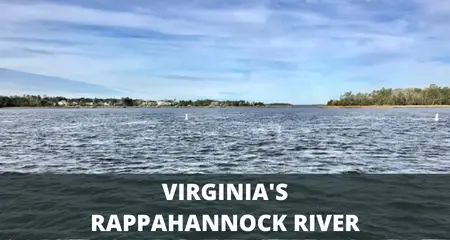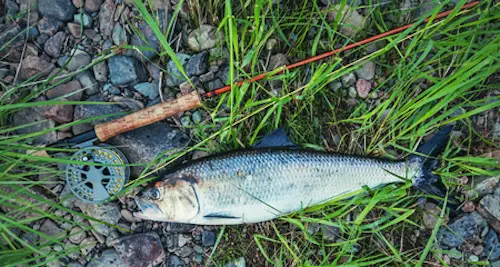Fishing The Rappahannock River in Virginia
UPDATED 03 NOVEMBER 2023
by Robert Ceran
One of Virginia’s great rivers, the Rappahannock, is home to many different kinds of fish, such as shad, small and largemouth bass, bluegills, catfish, and even stripers.
This historic waterway, which is popular with anglers from all over the Commonwealth, runs through the middle of Fredericksburg and has stayed mostly clean.

The “Rap,” as people in Virginia affectionately call it, has a long history of being a good place to fish.
George Washington grew up on a farm that his family owned near the Rappahannock River. This is where he spent most of his childhood.
Maybe the famous story about Washington cutting down a tree and telling the truth, which we all learned in elementary school, happened on the banks of the beautiful Rappahannock river.
I’m pretty sure that Washington wanted to make a fly rod out of that poor cherry tree.
Tidal changes make wading a challenge
Rappahannock is an Algonquian Indian word that means “waters that rise and fall quickly.” Because it is close to the Chesapeake Bay, the river is affected by changes in the tides.
I’ve waded out to the middle of the Rap more than once, only to find out later that I had to find a different way back to shore because the rocks I used to cross the river a few hours earlier had quietly sunk below the water’s surface as the tide changed.\
The fabled Rappahannock shad run in spring
Shad migrate into the Rappahannock River by the tens of thousands from the end of March to the first week of May.

I’ve seen schools of shad so big that the whole river looked dark and silvery. These shad weigh between 2 and 5 pounds, take flies eagerly, and fight hard once hooked.
Their big jumps on the line have earned them the name “poor man’s tarpon.”
Striped bass follow the shad up the river
Stripers quickly follow the shad up the river to spawn in the spring, and devoted striper fishermen on the Rap seem to get along well with the devoted shad fishermen.
This is probably because they fish at different times. Most striper fishermen go out at dusk, when shad fishermen are coming in from the river.
Imagine a scene that looks like a shift change for fishermen, with the “shaddies” telling the “stripers” that they’re after the wrong fish and that they should be fishing for real fish instead of fat minnows.
Bass and sunfish in summer
By June, stripers and shad are no longer around, so fishermen in warm water focus on bass and other sunfishes.
There are a lot of small islands and medium-sized boulders in the Rap that give these species a lot of structure.
When trees are swept downstream, they cause log jams. Eventually, the logs get caught on large boulders and catch more downed trees and other debris as they float by.
When you add a sandbar, a small island starts to form right in front of your eyes.
Bass and bluegill live close to these small islands, and the fallen structures are perfect places for fish to live.
What fishing setup should you use for the Rappahannock?
What you want to do on the Rap will determine what tackle you need. For shad in shallow water, use #5 and #6 weights on floating lines with the weight at the front.
Since shad hang out near the bottom of the water column, you might want to add some split shot to your line.
A sinking Polyleader is another option. It is tapered and can be added directly to your floating line. It acts as a sinking tip.
The Polyleader is made by Airflo and sold by Rajeff Sports. It comes in lengths from 4 to 8 feet and has different sink rates.
I usually add one of Airflo’s Super Fast Sinking Polyleaders to my floating line, then a few feet of tippet and a flashy little fly.
This setup lets you catch fish in water less than five feet deep without having to buy a sinking line. Polyleaders are easier to throw than split shot and can be used in other fishing situations.
I usually use an Airflo 200 or 300 grain Depth Finder when I’m fishing for shad or stripers in deeper water.
Obviously, you may need a heavier grain weight if the water is deeper or if there is a strong current. It goes without saying that you need heavier rods if you want to cast heavier lines.
Most of the time, you can catch stripers in the river with #8 or #9 weights. When the stripers leave the river later in the season, these same rods with floating lines can be used to catch bass.
The best flies to use on the Rappahannock
For the Rap, you’ll need a wide range of patterns in your fly box.
Remember that flies for shad need to be small and bright. Tommy’s Torpedo, which was made by saltwater guide Tommy Mattioli and comes in sizes #4 through #6, is a pattern I recommend.
The fly has a bright gold tail and is chartreuse, orange, red, and pink.
The Buggit is another good pattern for shad. It comes in bright colors and sizes #6 to #8 and is also used for trout and bass.
Striper flies range from size 4 to size 2/0 and come in many different colors. Stripers seem to bite best on Clouser Minnows that are blue and white, chartreuse and white, or all white.
As the season goes on, smallies and other pan fish love surface flies like Hickey’s Condor, Mr. Bob’s Poppers, and Walt’s Poppers. Woolly Buggers, Big Nasties, Jail Baits, sculpins, and dragonfly nymphs are all good subsurface patterns.
How to get to the Rappahannock
The Rap is easy to get to by car, and you can wade there if you are careful and wear shoes with felt bottoms.
The best place to walk up is by Falmouth Beach, where there is also a place to park. Take I-95 South to Rt. 17 South if you are in Northern Virginia (about 5 miles north of Fredericksburg).
Take Route 17 south for about 6 miles until it meets Route 1 south, then turn right. Turn right after about 100 yards and go under the Route 1 Bridge. On the right is Falmouth Beach.
If you cross the Route 1 Bridge to get into Fredericksburg, you’ve gone too far. Turn around on Route 1, and as soon as you cross the river, turn left.
